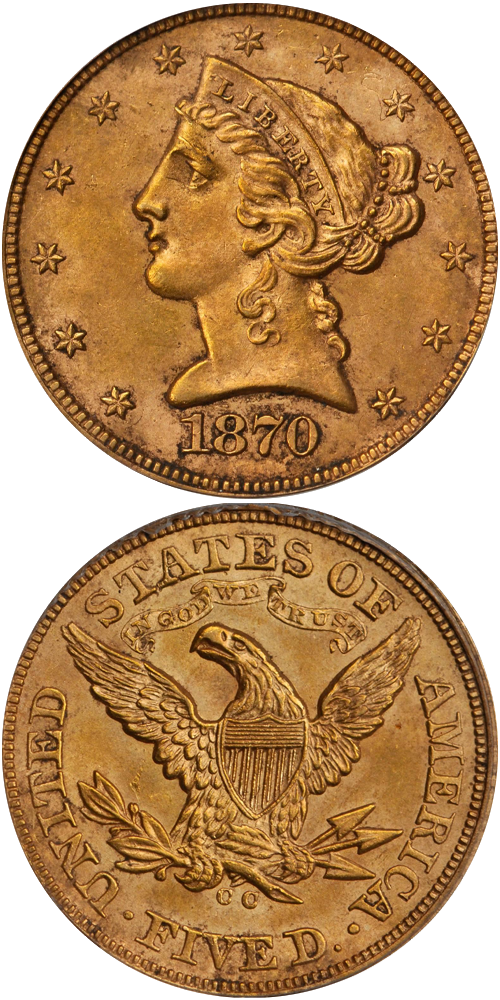1870-CC Liberty Head Half Eagle
Jeff Ambio: There is only a single die pair known for the 1870-CC Liberty half eagle. The obverse has the date slanting down to the right with the digit 1 close to the truncation of the neck and the digit 0 (zero) distant. A loupe reveals a few faint die file marks from the tip of the coronet to star 6. On the reverse, the CC mintmark is uneven with the first C high and nearly touching the arrow feather. The second C is lower and close to the olive branch, but is clearly separated from it. A raised die defect is present on the scroll at the letter S in STATES; this feature is present on certain 1871-CC, 1872-CC and 1873-CC half eagles, proving that this reverse die remained in use through the final-listed year.
Two different die states are known for the 1870-CC half eagle. Die State I examples are sharply struck throughout, while on Die State II coins the centers are softly impressed with the eagle's head and neck on the reverse particularly blunt and more or less devoid of feather detail. Die State I coins are much rarer in numismatic circles than their Die State II counterparts, with Rusty Goe (The Mint on Carson Street, 2003) stating that, "Problem-free specimens [of the 1870-CC half eagle] with sharp strikes are worth considerable premiums in any grade."
Despite at least one estimate in the numismatic literature that ranges as high as four to six coins, we believe that there are no more than three 1870-CC half eagles extant that qualify as Mint State. Just two of these coins have currently been certified by PCGS and NGC.
Rusty Goe: On New Year's Eve 1869, just days before the Carson City Mint was scheduled to open, San Francisco's Daily Alta newspaper said, "It is high time that this ancient absurdity of Parent Mint and Branch Mint were disposed of..." The article said that "when the Republic was in its infancy and Philadelphia was its seat of Government, a humble and rude establishment for coining gold and silver was set up at the National Capital." But, "When the Government changed its seat to Washington, the Mint was left behind, being of not enough consequence to move." The Alta went on to provide a brief history of the development of mints in other parts of the country, leading up to the establishment of one in Carson City, Nevada.
On January 8, 1870, when Superintendent Abraham "Abe" Curry officially opened the mint in Carson City for business, it mattered little to him what the government would call it. He had exerted much energy over the past eight years to get his coin factory, mint, branch, or whatever anyone else wanted to name it, up and running.
Curry's enthusiasm stemmed from his knowing that his mint would stamp out the same kind of silver and gold coins as did the "Parent" in Philadelphia or the neighbor branch in San Francisco. In 1870, the Carson Mint kept pace with those other two facilities in the coinage of gold half eagles and eagles, although it did not compete (nor would it ever) in the production of the larger double eagles.
Coiner Ezra Staley delivered the first 400 1870-CC half eagles on March 1. The coining department delivered another 1,490 pieces before June 30, and then added 5,785 more in the second half of the year. The total output of 7,675 half eagles for that first year compared with the 4,000 examples minted in Philadelphia in 1870, and the 17,000 turned out in San Francisco.
Possibly only one to one and a half percent of the original mintage of 1870-CC half eagles survives today.
In 1994, a Carson City mailman working his route on a typical day noticed in disturbed earth, a small round piece of metal glistening like gold. He bent down, picked it out of the dirt and saw it was a $5 gold piece, dated 1870. On the reverse, he saw the two little "Cs." At the earliest opportunity, he took his discovery to Old Mint Coin and Bullion located across the street from the Nevada State Museum (the old Carson City Mint building). The shop's owner, Joel Mitchell, bought the coin for an undisclosed price and in due time took it to his brother Tony's shop in Reno. Tony submitted the coin to PCGS where it received the MS-61 grade seen on the coin's certificate today. After offering the newly found treasure to at least one other collector, the Mitchell brothers gave Mr. Battle Born a shot at it and after some contemplation he bought it.
Q. David Bowers: The half eagle mintage at Carson City in 1870 was 7,675 of which Rusty Goe estimates that 85 to 105 exist in all grades with four to six Uncirculated. I view the Uncirculated population as being slightly less, but gradeflation has changed estimates from the old days. If there are as many as six, I would bet that one or some would have been called AU by me in earlier times. As to circulated examples, my estimate is 40 to 55.
The early gold coins of the Carson City mint were placed directly into commerce, where they circulated extensively. These circulated at par in the West at a time when gold coins were not seen in circulation in the East or Midwest.
The example to the left was sold by Stack's Bowers Galleries in the August 2012 Battle Born Collection of Carson City Coinage, where it realized $105,750.






